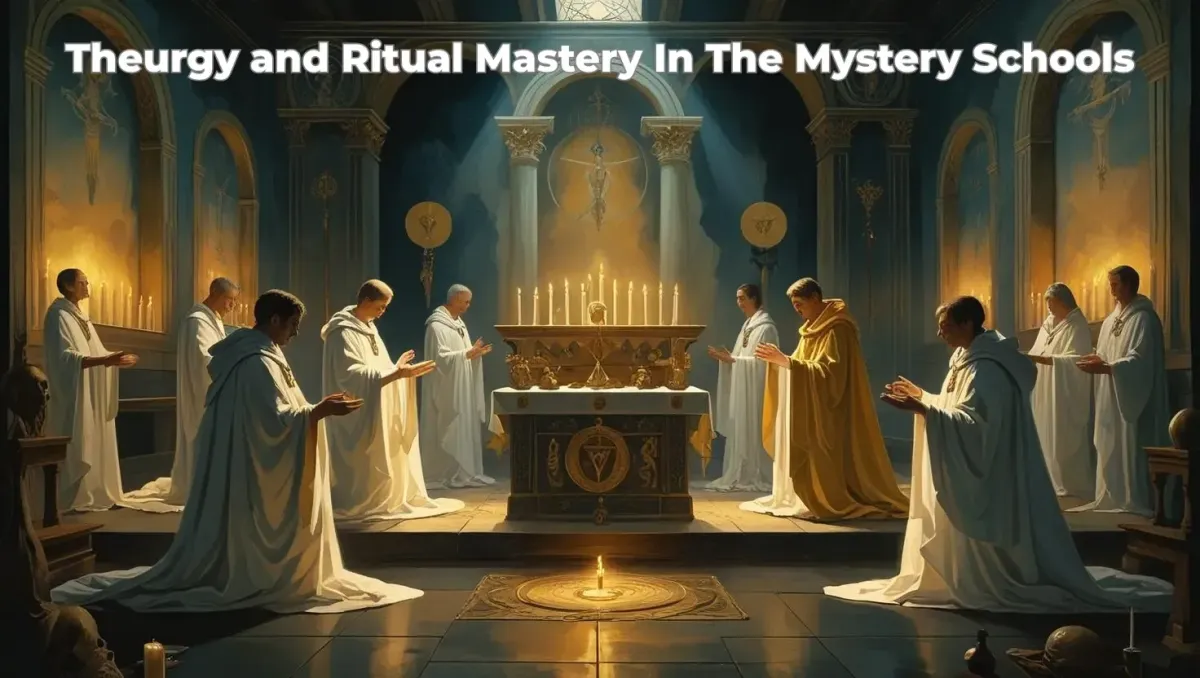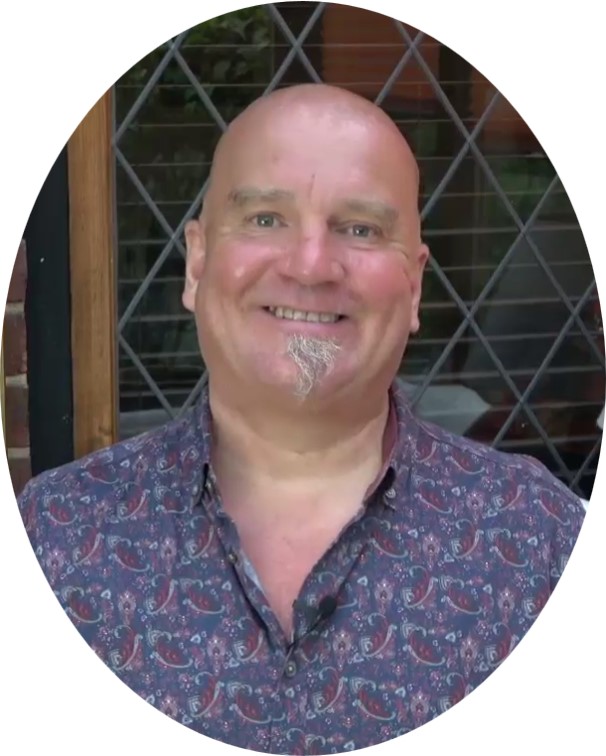
Theurgy and Ritual Mastery: Invoking the Divine in Mystery School Initiation
When we think of ritual, it’s easy to picture incense, chanting, or symbolic gestures. But in the mystery schools, ritual was far more than ceremony. It was a technology of the sacred — a way to align human beings with the divine order.
The most advanced form of this ritual practice was known as theurgy — literally “divine work.” Far from superstition, theurgy was the disciplined art of invoking the presence of the divine, not to control it, but to commune with it. It was the pinnacle of initiation, where philosophy, meditation, and symbolism came together in living experience.
In this article, we’ll explore what theurgy meant in the mystery schools, how rituals were structured, the philosophy behind them, and why ritual mastery remains a powerful path of transformation today.
New to mystery schools? Start with our overview article “What Are Mystery Schools?” and then visit the Mystery School hub for classes, courses and next steps.

What Is Theurgy?
What theurgy is (plain English)
Theurgy means “divine work.” It’s the late-antique idea that ritual, prayer, hymn, symbol and sacred timing can align the human soul with the divine. Think co-operation with grace, not control.
In Neoplatonism (Iamblichus, Proclus), theurgy complements philosophy: rational study prepares you, ritual perfects you. It aims at transformation, not spectacle. (Stanford Encyclopedia of Philosophy)
The word “theurgy” comes from the Greek theourgia, meaning “god-work” or “divine operation.” In the mystery traditions:
It was not about manipulating external forces (as some forms of magic were accused of being).
It was about invoking divine presence — creating a bridge between the human and the transcendent.
Theurgy was the highest stage of initiation, requiring years of purification and preparation.
To understand the philosophical foundation behind this, see Esoteric Philosophy & Magic: The Secret Teachings of Mystery Schools.
Source texts at a glance
Chaldean Oracles (2nd–3rd c. CE): fragmentary hexameters that shaped later ideas of theurgy and sacred ascent. (oxfordreference.com)
Iamblichus, De Mysteriis (On the Mysteries): a defence of theurgic ritual, framed as replies to Porphyry’s doubts. Central for how late Platonists understood ritual. (Wikipedia)
Proclus (5th c.): develops a full metaphysics and practised hymnody; treats theurgy as part of the soul’s return to the One. (Stanford Encyclopedia of Philosophy)
Theurgy vs Magic (why words matter)
Writers of the time often contrasted theurgy (ritual aligned to divine order, purification, ascent) with goetic or coercive magic. Theurgic rites weren’t meant to force outcomes, but to tune the soul and honour hierarchies of being. Keep the frame ethical, not sensational. (Encyclopedia)
What rites looked like (from the sources)
Ancient testimonies mention hymns, consecrations, prayer sequences, images, and sometimes telestikē (consecration or “animation” of statues) as symbolic mediations. Evidence is patchy and often allusive; scholars disagree on details, so read with care and avoid literalism. (Dalhousie University Libraries)
How to read theurgy today
Treat it as a symbolic map for humility, alignment, and embodied reverence. It sits alongside study, ethics, and steady practice. If a modern teacher promises power, shortcuts, or special status, step back. The authentic thread is purification → participation → praise—not performance. (Stanford Encyclopedia of Philosophy)
The Philosophy Behind Ritual
Ritual in the mystery schools was built on several metaphysical principles:
Correspondence: The idea that earthly actions mirror cosmic patterns — “as above, so below” (The Hermetic Principles: Universal Laws of the Mystery Schools).
Vibration: Sound, chant, and movement could align human energy with divine frequencies.
Symbolism: Objects, gestures, and sacred geometry encoded universal truths (Sacred Geometry: Patterns of the Divine in Mystery School Teachings).
Polarity and Union: Rituals often brought opposites together — light and dark, masculine and feminine — to reveal unity.
These principles ensured rituals were not empty performance, but living philosophy embodied.
The Structure of Ritual Initiation
While each school had its unique ceremonies, the core structure of ritual often included:
Preparation
Purification through fasting, prayer, or meditation.
Aligning the initiate’s intention with divine purpose.
Invocation
Chanting sacred words or divine names.
Lighting candles, burning incense, or using planetary alignments (Astrology, the Stars, and the Mystery Schools).
Sacred Action
Performing symbolic gestures or walking patterns (often geometric in form).
Acting out archetypal dramas representing death, rebirth, or union.
Union
The initiate entered a state of communion — sometimes visionary, sometimes felt as profound peace.
Integration
Teachers helped initiates interpret and ground their experiences, often through reflective psychology (Reflective Psychology and Psychism: The Inner Work of Illumination).
Theurgy as Spiritual Ascent
For the Neoplatonists and Hermetic initiates, theurgy was a path of ascent through the spheres — rising from the material world to union with the divine.
Symbols and invocations acted as steps on this ascent.
The initiate moved from the earthly to the celestial, guided by ritual forms.
At the highest point, the soul experienced itself as one with the eternal source.
To see how this connects to ontology and being, read Metaphysics & Ontology: Mystery Schools and the Nature of Reality.
Tools of Theurgic Ritual
Mystery schools used specific tools to focus divine invocation:
Sacred Geometry: Temples built on precise proportions amplified spiritual energy.
Sigils and Divine Names: Written or spoken symbols invoked higher beings.
Elemental Forces: Fire, water, earth, and air were used to mirror cosmic creation.
Celestial Alignments: Rituals timed with solstices, equinoxes, or planetary conjunctions enhanced potency.
These tools were never ends in themselves — they were doorways through which initiates touched higher realities.
The Balance of Power and Purity
Theurgy demanded rigorous discipline. Without preparation, initiates risked being overwhelmed by the forces they invoked. This is why the mystery schools insisted on:
Purification of motives: Compassion and service were the anchors (Compassion-Based Energy Work: Heart-Centred Alchemy in the Mystery Tradition).
Meditative training: Only a still mind could receive divine presence (Esoteric Meditation: Initiatory Practices for Inner Vision).
Moral grounding: Ego-driven intent could distort ritual into something destructive.
Ritual mastery was never about power for its own sake. It was about becoming a clear vessel for divine light.
Historical Echoes of Theurgy
We see glimpses of theurgy throughout history:
Egyptian Temples: Priests invoked the gods through ritual drama and sacred space.
Greek Mysteries: Initiates of Eleusis underwent ceremonies symbolising death and rebirth.
Neoplatonic Theurgy: Philosophers like Iamblichus described ritual as the soul’s ascent to the divine.
Renaissance Magicians: Figures like John Dee sought angelic communication through complex ceremonies (John Dee and the Hidden Knowledge of the Renaissance Mystery Schools).
Even in later Christian and esoteric traditions, echoes of theurgic practice remain in sacraments, liturgies, and ceremonial magic.
Why Theurgy Still Matters Today
In modern spirituality, many rituals have been stripped of their original depth. Theurgy reminds us of the true purpose of ritual: to invoke divine presence and transform the soul.
It shows us that ritual is not superstition but a science of consciousness.
It reveals that symbols and gestures can open profound states of union.
It grounds philosophy in living practice, ensuring wisdom is embodied.
For today’s seekers, rediscovering ritual mastery can bring meaning, connection, and sacredness back into everyday life.
To see how theurgy fits into the broader framework, revisit What Are Mystery Schools? The Hidden Lineage of Ancient Wisdom.
Safety & discernment — a quick note
Choose communities that widen agency and consent. Look for transparent pricing, clear refunds, realistic claims, boundaries, and aftercare. Decline secrecy-for-payment or miracle marketing. If your body says “no,” pause, breathe, and seek a second view.
Next Steps On Your Mystery School Path
If this article spoke to you, don’t leave it as just an interesting idea. Take one gentle step to deepen the journey:
Visit the Mystery School hub to see all classes and courses in one place.
Explore Beyond The Veil for a structured, safe deepening of inner practice and spiritual cosmology.
Continue reading with these related articles:
Neoplatonism and Theurgy: The Simple Map Behind Western Mysticism
Magic vs Magick (Beginners’ Guide): Language, Lineage, Ethics
How to Vet a Mystery School: Ethics, Fees, Promises & Red Flags
Choose the one that feels kindest and most alive for you right now, and let the work unfold at your own pace.

Theurgy is the art of becoming a bridge between the human and the divine. It is not about gaining control, but about surrendering to higher order and allowing transformation to flow through you.
At the Bright Beings Academy Mystery School, you can explore the role of ritual and theurgy alongside teachings on Hermetic Principles, Meditation, Alchemy, and Sacred Geometry.

FAQs Theurgy and Ritual Mastery in the Mystery Schools
What is theurgy?
Theurgy means “divine work” and refers to rituals designed to invoke divine presence and elevate the soul.
How is theurgy different from magic?
Magic often sought to influence the world, while theurgy sought communion with the divine. It was considered the highest form of ritual in the mystery schools.
What kinds of rituals were used?
Ceremonies using sacred geometry, divine names, symbolic actions, and celestial timing were common, always performed with disciplined preparation.
Can theurgy be practised today?
Yes. Modern ritual, meditation, and symbolic practices can all serve as forms of theurgy when approached with purity, intention, and devotion.
Is theurgy just another word for magic?
No. In late antiquity it meant ritual cooperation with the divine for purification and ascent, not coercion. (Encyclopedia)
Where does the idea come from?
From the Chaldean Oracles and later Neoplatonic writers like Iamblichus and Proclus. (oxfordreference.com)
What’s in Iamblichus’ De Mysteriis?
A structured defence of theurgy as necessary for completion of the philosophical path—answering Porphyry’s critiques. (Wikipedia)
Did they really “animate” statues?
Some sources discuss telestikē as ritual consecration of images. Scholarship warns that evidence is indirect; treat it as symbol-practice, not movie magic. (JSTOR)
How did Proclus see theurgy?
As integrated with metaphysics, hymn, and prayer—the soul returns by participating in divine order. (Stanford Encyclopedia of Philosophy)
How should I approach this today?
With humility, ethics, and embodied practice. Use the symbolism to cultivate reverence and responsibility, not specialness. (Stanford Encyclopedia of Philosophy)
Further reading
Neoplatonism and Theurgy: The Simple Map Behind Western Mysticism
The Emerald Tablet and As Above, So Below: A Plain-English Explainer
Alchemy Stages: Nigredo to Rubedo — The Inner Transformation Map
How to Vet a Mystery School: Ethics, Fees, Promises & Red Flags
I look forward to connecting with you in my next post.
Until then, be well and keep shining.
Peter. :)
